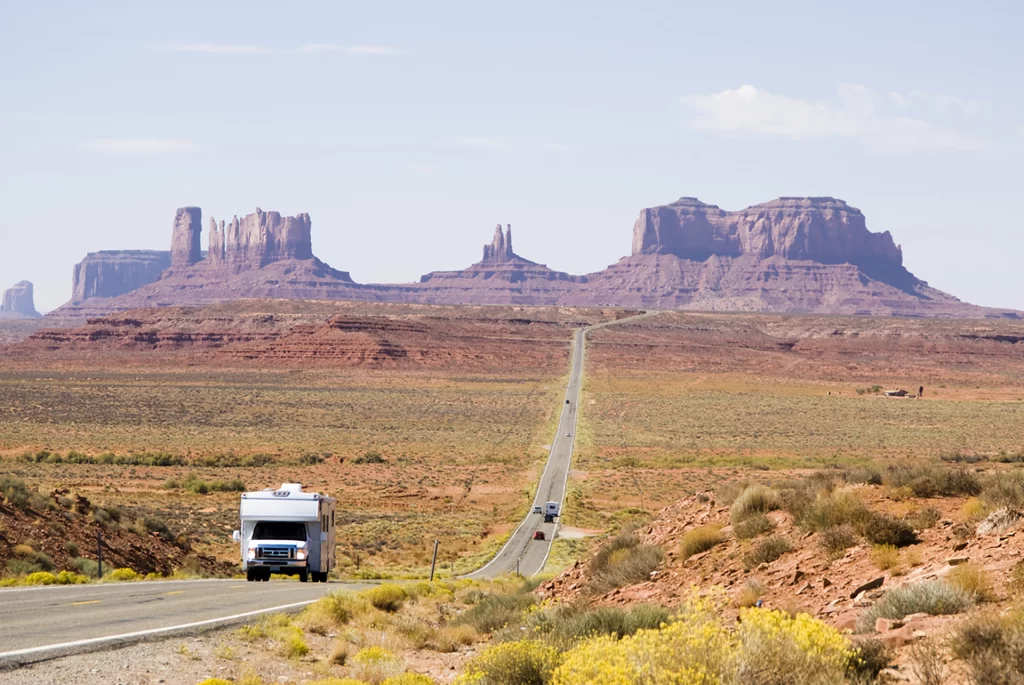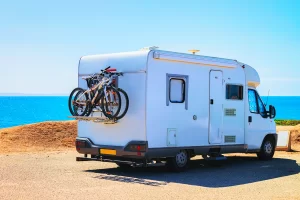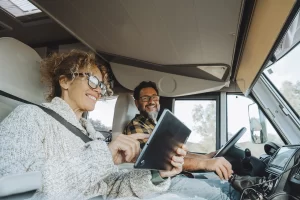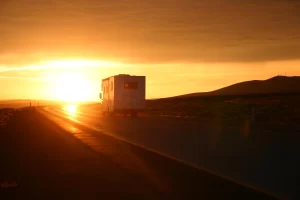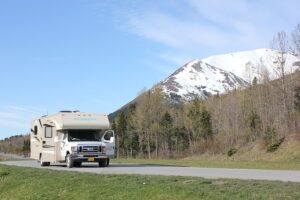
Embarking on a cross-country RV trip is a dream for many. The freedom of the open road, the endless possibilities, and the sense of adventure that comes with reaching your destination and everything in between is an unparalleled experience.
Whether you’re an RV enthusiast looking to take the ultimate road trip or an adventure seeker longing for that perfect mix of thrill and comfort, this detailed guide will ensure that your upcoming escapade is nothing short of incredible. From mapping out your route to staying safe on the road, every aspect is covered to help you plan the ultimate cross-country RV trip.
Start Your Planning Early
Picture it — the west’s sprawling desert plains, the central states’ lush forests, the vibrant cities filled with culture and history, and the sweeping coasts of the east. The landscape that unfolds before you on a cross-country RV trip is nothing short of breathtaking, and the experience is hard to come by in any other form of travel.
Yet, the allure of such a grand undertaking can also be overwhelming. With every mile you traverse, there are cities to see, natural wonders to behold, and countless memories to make. Before you hit the road, you must take the time to plan and savor the possibilities that lie ahead.
This guide is your roadmap to making the most of your cross-country RV adventure. It will offer you valuable advice on how to meticulously plan every part of your trip so you can relax and enjoy the experience with peace of mind, knowing that every aspect has been carefully managed.
Step 1: Setting the Route
Your route is the backbone of your trip, and deciding where you want to go will set the stage for everything else that follows. There’s a delicate balance between covering all the must-see stops and having enough time to experience each place genuinely. Here are some tips to consider when planning your route:
- Start with a general outline: Begin by identifying the main stops you want to make, whether they’re cities, national parks, or famous landmarks.
- Consider time and distance: On average, RVs travel at about 50 miles per hour. Factor in driving time and rest days when calculating the amount of time you’ll need to cover your desired route.
- Be selective: It’s tempting to want to see everything, but it’s better to prioritize and have a more leisurely pace than trying to cram too much into your trip.
- Plan for detours: Part of the charm of RV travel is being flexible enough to take unplanned detours. Leave room in your schedule for unexpected adventures.
- Research RV-friendly routes: Not all roads are suitable for RVs, so be sure to research and plan your route accordingly.
Researching Destinations
Begin your planning by researching the vast array of destinations that a cross-country trip offers. From national parks to landmarks, the United States is teeming with places of interest. Make a list of those that are non-negotiables, and consider the best season to visit each location. Understanding the weather patterns and events can influence both your route and the timing of your trip.
Additionally, look into the RV parks and campsites in each location. Make reservations if possible, as some places can fill up quickly during peak seasons.
Planning Stops and Attractions

Next, plot your trip on a map and identify potential overnight stops and points of interest along the way. Consider spending more time at destinations that are significant to you or align with your interests. Remember, this trip is a balanced blend of destination and the experiences that happen in transit.
Also, research activities and attractions in each area. Are there any local festivals or events happening during your stay? Is there a must-see attraction that you don’t want to miss?
Plan accordingly to make the most of every stop.
A great tool for planning is the RV Trip Wizard, which can help you determine the best route, find RV parks, and estimate the cost of fuel for your trip. Be sure to account for travel times and distances realistically, taking into consideration the size and capabilities of your RV.
Step 2: Budgeting and Financial Planning
A cross-country trip can offer month’s worth of adventures, and with that, comes a substantial need for financial planning. Your budget will determine the length of your trip, the quality of your accommodations, and the number of activities you can participate in.
Estimating Costs
Outline the major expenses including fuel, accommodations, food, and activities. Look for online calculators that can give you a rough estimate of fuel costs based on the planned route. Don’t forget to set aside money for unexpected repairs, souvenirs, and any insurance needed for your trip.
Saving Strategies
Cutting down on expenses can help you save for your trip and extend the length of your journey. Consider ways to reduce costs, such as cooking meals in your RV instead of eating out or staying at free campsites instead of paid ones. Additionally, earn some extra income by renting out your home or taking on a side hustle before you hit the road.
Setting a Budget
Once you have a good estimate of your trip’s cost, set a realistic budget. This will help to avoid overspending and allow you to enjoy your experience without the anxiety of running out of funds. Remember to be flexible, as you might find ways to cut costs or may decide to splurge on special activities or events.
Consider the costs of staying at RV resorts versus primitive camping or balancing paid activities with free experiences. Always be sure to have a cushion of extra funds for emergencies or spontaneous opportunities that may arise.
Picking the Right RV
Choosing the right RV for your trip is a crucial step in planning. Consider the size, amenities, and overall capabilities of the vehicle. RVs come in different classes, sizes, and styles:
- Class A motorhomes are the most substantial and luxurious, with all the amenities of a home on wheels.
- Class B motorhomes, or camper vans, offer a more compact and budget-friendly option for smaller groups.
- Class C motorhomes are a mid-size option that offers a balance of space and price.
Whichever class you choose, make sure to test drive and inspect the RV thoroughly before committing to rent or purchase. If possible, attend RV shows to see a variety of options and speak with experienced RV owners.
Step 3: Preparing Your RV
Your RV is your mode of transportation and your home on the road. Preparing it adequately is crucial for a smooth and enjoyable trip.
Maintenance Check
Before you leave, take your RV to a certified dealership for a thorough maintenance check. This should include engine and fluid checks, tire inspections, and ensuring that all systems are in good working order. Don’t forget to check your generator and all electronic functions. Addressing any potential issues ahead of time can save you from headaches down the road.
Packing Essentials
Creating a packing list is an indispensable step in the preparation process. Think about items you’ll need for cooking, sleeping, and daily essentials. Remember to pack versatile clothing for various weather conditions and outdoor gear if you plan to spend time in nature.
For a comprehensive packing guide, start with the essentials such as:
- Tools and RV repair kits
- Cookware and utensils
- Bedding and towels
- Personal items
- RV-friendly toilet paper and cleaning supplies
- Leveling blocks and chocks
- Sewer hoses and water hoses
- All electrical and water plug adapters you might need for various campsite hookups

Each item you bring should serve a purpose and contribute to the success and enjoyment of your trip. Once you’ve packed, organize your storage effectively to ensure everything has its place and is easily accessible.
Step 4: Safety and Emergency Preparedness
No matter how well you plan, emergencies can happen. Preparing for them will give you the confidence to handle unexpected situations with grace.
First Aid Kit
Stock your RV with a well-equipped first aid kit tailored to meet your travel companions’ needs. It should include basic supplies like bandages, antiseptics, pain relievers, and any prescription medications.
Consider your route when preparing your kit — if you’re traveling through remote areas, include supplies for treating snake bites or other specific injuries that might be more common in that terrain.
Food and Water Supply
Having enough food and water to sustain you on your trip is essential. Plan for at least three days’ worth of supplies, which will come in handy if you get stranded or experience unexpected delays. Consider packing non-perishable items that don’t require cooking in case of a power outage or failure of RV systems.
Vehicle Safety and Security
Always lock your RV when you leave it unattended. Consider investing in additional security measures such as wheel locks or an alarm system. Practice safe driving habits and follow all traffic laws to avoid accidents.
RV Repair Tools
While you don’t need to be a mechanic, having some essential tools and knowledge of how to handle minor repairs, such as changing a tire, can save you time and money on the road. Consider taking an RV maintenance course or watching online tutorials to familiarize yourself with common troubleshooting techniques.
Emergency Contacts
Compile a list of emergency contacts including local hospitals, emergency services, and the contact information of a close friend or family member who is not on the trip.
Also, ensure that you have a reliable method of communication, whether it’s a cell phone with good coverage, a satellite phone, or a portable Wi-Fi hotspot.
Plan for the worst by researching RV roadside assistance options. Many insurance companies offer comprehensive plans that can provide peace of mind in the event of a breakdown or an accident.
Step 5: Enjoying the Journey
After all the planning and preparations, your trip is finally underway. Here are tips to ensure you make the most of every moment.
Tips for a Memorable Experience
Engage with locals, fellow travelers, and the environment. These interactions enrich the experience and can lead you to hidden gems that aren’t on the typical tourist path.
Leave room in your itinerary for spontaneity. Sometimes the best experiences aren’t planned and chance encounters can lead to the most memorable moments of your trip.
Take care of your RV and the environment. Dispose of waste properly, follow all campground rules, and respect your surroundings.
Leave no trace and help preserve nature for future travelers.
Staying Connected
While it’s essential to disconnect from technology and enjoy nature, staying connected is crucial for emergencies or if you’re on an extended trip. Keep friends and family updated with your location and any changes in your itinerary.
Utilize online resources like RV forums and social media groups to connect with other RVers, get tips on places to visit, and share experiences.
Balancing Paid Activities with Free Experiences
Exploring new places can be costly, but it doesn’t have to break the bank. Balance out paid activities with free experiences such as hiking, visiting a local farmer’s market, or exploring small towns. These experiences can be just as fulfilling and can help save money for longer trips.
Just remember to enjoy the journey and embrace everything RV travel offers. From the freedom of the open road to the beautiful destinations you’ll discover, it’s a unique and rewarding experience that will leave you unforgettable memories.
Flexibility in the Itinerary
While having a plan is essential, being flexible is just as crucial. Emergencies, inclement weather, or simply falling in love with a place and wanting to stay longer can all throw a wrench into your itinerary.
Learn to adjust your expectations and schedule on the fly. It’s all part of the adventure and the mark of a seasoned traveler. Maybe you’ll bypass a few planned stops in favor of taking a longer scenic route, or perhaps you’ll decide to return to a place you can’t get enough of on a future trip.
Experience the RV Lifestyle
Planning the ultimate cross-country RV trip is an adventure in and of itself. The process allows you to anticipate the rich experiences that lie ahead while also preparing you for the unexpected. Remember to cherish every sunset, every conversation, and every mile traveled. This is more than a trip — it’s a transformational experience that will leave you with a lifetime of stories to tell.
